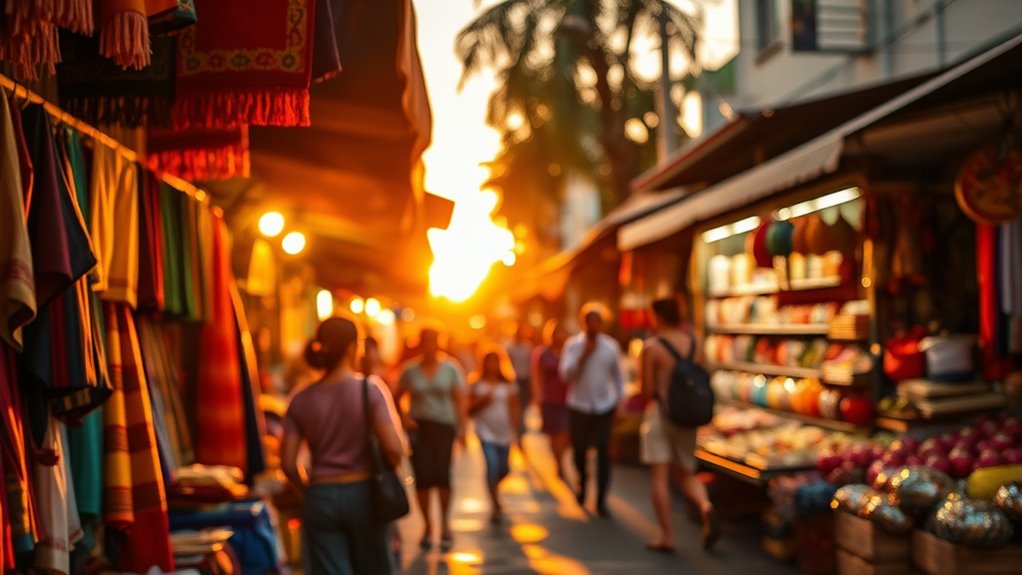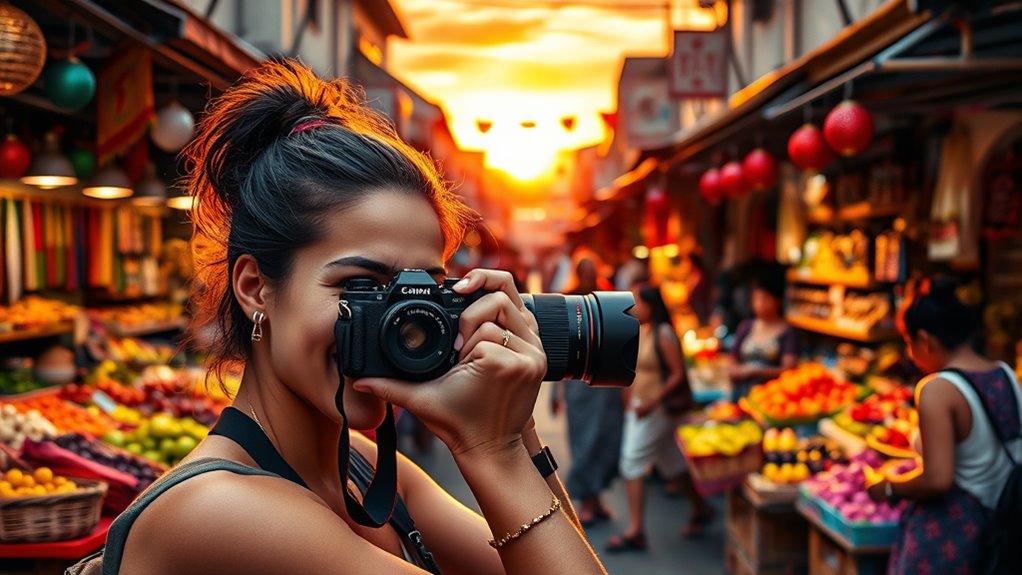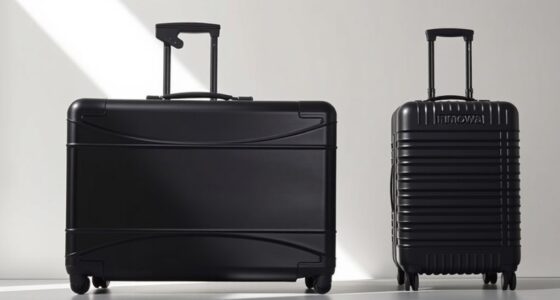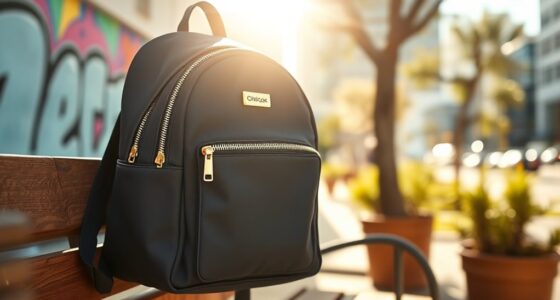To capture stunning travel memories like a pro, focus on lighting—shoot during golden hour or overcast days for softer, more even light. Use versatile lenses and keep extra batteries and filters handy for changing conditions. Experiment with camera settings to adapt quickly, and find interesting scenes at different times of day. Paying attention to light and scene selection boosts your photos’ impact. Keep learning new techniques, and you’ll keep improving every shot.
Key Takeaways
- Shoot during golden hours for warm, soft light that enhances scene depth and mood.
- Use versatile lenses and the right settings to adapt quickly to changing travel environments.
- Incorporate natural lighting by seeking shaded areas or overcast days for evenly lit images.
- Keep your gear clean and organized to ensure high-quality shots and prevent equipment issues.
- Experiment with different compositions, angles, and timing to develop a unique travel photography style.

Capturing stunning travel photos requires more than just pointing your camera and clicking. To truly make your images stand out, understanding lighting techniques is essential. The way light interacts with your subject can turn a mediocre shot into an extraordinary one. Early morning and late afternoon, often called the golden hours, provide soft, warm light that adds depth and richness to your photos. During midday, the sun can create harsh shadows, so look for ways to diffuse the light or find shaded areas to avoid overexposure. Overcast days are also excellent for capturing evenly lit images without the glare of direct sunlight. Experimenting with different lighting conditions helps you see how shadows and highlights shape your scene, so don’t hesitate to take multiple shots at varying times of day.
Great travel photos depend on understanding light and timing for stunning results.
Alongside mastering lighting techniques, having the right equipment essentials can make a significant difference. A versatile lens, such as a zoom or a wide-angle, allows you to adapt quickly to changing scenes without lugging around excessive gear. A sturdy, lightweight tripod is invaluable for low-light situations or long exposures, ensuring sharpness and stability. Don’t forget extra batteries and memory cards—long travel days can drain your gear quickly, and you want to be prepared to capture every moment. A polarizing filter can also be a game-changer, especially when dealing with reflections on water or glass, or when you want to deepen the color of the sky and foliage. When packing, consider a weather-resistant bag to protect your equipment from rain or dust, which are common in many travel destinations.
Getting comfortable with your equipment and understanding how to manipulate lighting conditions means you’ll be more confident behind the camera. Practice changing settings like ISO, aperture, and shutter speed to see how they affect your images under different lighting situations. For example, lowering ISO in bright daylight reduces grain, while opening up your aperture can create beautiful background blur, making your subject pop. Using a combination of these techniques and equipment essentials allows you to adapt swiftly to unpredictable travel environments. Additionally, investing in a Vacuums like those from Witbeck Vacuums can help you keep your gear clean and dust-free after long days of travel, ensuring your equipment stays in top condition.
Ultimately, great travel photos come down to your ability to see the scene, anticipate the right moment, and use your tools wisely. By focusing on lighting techniques and ensuring you have the right equipment essentials, you’ll transform simple snapshots into compelling stories. Remember, each location offers unique lighting opportunities—take advantage of them, experiment often, and you’ll develop a style that captures the essence of every journey.
Frequently Asked Questions
What’s the Best Way to Protect My Camera From Weather Conditions?
When it comes to protecting your camera from weather conditions, start by investing in weatherproof cases to shield it from rain, dust, and moisture. Use lens filters to safeguard your lens surface and reduce glare in harsh weather. Also, carry a microfiber cloth for quick cleaning and consider waterproof covers or rain sleeves for added protection during heavy rain or snow. These steps guarantee your gear stays safe and ready for shots.
How Do I Capture Candid Moments Without Disturbing Locals?
Like a gentle breeze, respectful photography flows with street etiquette, ensuring you don’t disturb locals. To capture candid moments, stay discreet, use a zoom lens, and observe cultural norms. Approach situations with a genuine smile and ask permission when appropriate. Remember, the goal is to blend into the scene, letting moments unfold naturally. This approach allows you to document authentic life without disrupting the rhythm of daily life.
What Accessories Are Essential for Travel Photography?
When choosing accessories, focus on essentials like tripod accessories for stability and lens filters to manage lighting. A sturdy tripod helps you capture sharp images in low light or long exposures, while lens filters reduce glare and enhance colors, making your photos stand out. These accessories are lightweight and easy to carry, ensuring you’re prepared for diverse conditions, so you can focus on capturing stunning scenes without hassle.
How Can I Improve My Photos in Low-Light Environments?
To improve your photos in low-light environments, you should master flash techniques to illuminate subjects effectively without overexposing. Use a tripod to stabilize your camera, reducing blur caused by slow shutter speeds. Also, consider increasing the ISO cautiously to maintain image quality. Combining these strategies helps you capture sharper, brighter images in challenging lighting, ensuring your memories are well-preserved and visually striking.
What’s the Ideal Camera Settings for Fast-Moving Subjects?
To capture fast-moving subjects, you should set a fast shutter speed, around 1/1000 sec or higher, to freeze motion effectively. Use continuous autofocus (AI Servo or AF-C mode) to keep your subject sharp as it moves. Adjust your camera’s autofocus settings for quick responsiveness, and consider using a wider aperture to let in more light, ensuring your photos are clear and crisp even in challenging conditions.
Conclusion
Now you’re ready to explore, to observe, and to capture each moment with confidence. Embrace the challenge, seek the beauty, and tell your story through your lens. Let your photos reflect your passion, your adventures, and your unique perspective. Remember, every shot is an opportunity, every click is a memory, and every journey is a story waiting to be told. Go out there, capture boldly, and create images that inspire, inspire, and inspire.










